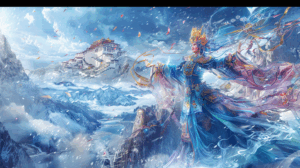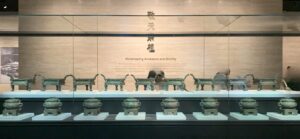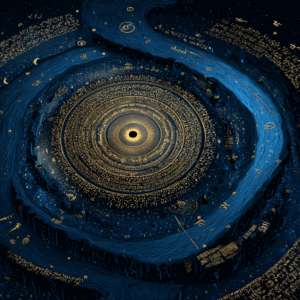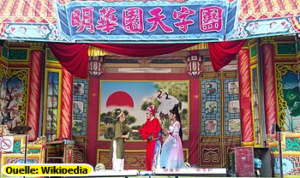一縷高原冷香,伴著千里風雪嫁衣。
桃花雖短,香氣卻長,埋在歲月之下,靜靜盛開在雪山深處。
本篇探尋的是「文成公主入藏」,開篇便回望那場橫越千里的聯姻。
傳說布達拉宮,便是松贊干布為迎娶尺尊公主與文成公主所建。
貞觀十五年(公元641年),唐太宗李世民遣江夏郡王、禮部尚書李道宗護送文成公主入吐蕃,她攜帶著釋迦牟尼像、珍寶、經書三百六十卷作為嫁妝,還有一囊中原之香。
松贊干布遠從邏些(今拉薩)趕至柏海相迎,千里風雪之行,正是香氣與信仰交會的旅途。
公主自長安出發,身披華服,手持香囊,歷經羌地與雪域,終在林芝桃花盛開時,抵達命運的渡口。
傳說中,布達拉宮是松贊干布為迎娶尺尊公主與文成公主所建。這座聳立於紅山之上的殿宇,承載著一場政治聯姻背後的千年餘韻。然而在布達拉宮之前,帕邦卡才是最早的靜修之所。
松贊干布遷都拉薩後,先建布達拉宮,再修帕邦卡。這裡,既是談論國事、接待使者之地,也是一對政與心合的夫妻,在香煙繚繞的石上屋宇間共同修行的地方。
帕邦卡山上的白屋,是松贊干布打坐處;而最頂層的黃房,據說則為文成公主所居。山間有一株古老桃樹,相傳為她親手所植。
若花開之時,正逢她香囊中焚起那縷中原之香 –
高原桃香與沉穩乳香混合,在西藏天空下緩緩升起,如夢如詩。
她,精通曆法與占卜,亦知香氣能安魂定志;
她不是一位普通的公主,而是「香」的使者。
香未散,人未還,但一整座高原,記住了她走過的氣味。
高原上的春天來得比誰都遲,也比誰都真。
桃花開時,雪未融,風依舊冷,但那花香,卻不躲不退,像是千年來第一次呼吸自由。如果說江南的桃香是一場夢,那林芝的桃香就是一次覺醒。
花開在冰雪交界處,不是為了嬌媚,而是為了頑強。文成公主焚香而行,她走過的不是婚路,是文化的橋,是信仰的徑。
她帶來的不只是人與書,更是香。那香氣中,有中原的思念,也有對未來的安撫。在空氣稀薄的高原上,嗅覺反而變得敏銳。
一縷桃香,能讓記憶回到未嫁時的夢中臥閣,也能提醒她,身在異域,更要柔中有剛。古人合香,講究「君臣佐使」,但在林芝這片空谷中,一切都被自然重寫。
雪是君,風是臣,桃是香的魂,而她,是唯一的使者。桃香不只是浪漫,它更是一種渡世之力。
柔者不碎,香者不朽。文成公主未言,但香氣已先到,先於語言,也勝於語言。有些香氣,是為了記憶某個人;
有些香氣,是為了讓人記住一段路。文成公主的桃香,是後者。今日拉林高鐵開通,時速160;當年駝隊萬里,步步辛苦。
但香氣穿越的,從不是距離,而是信念。「桃花依舊笑春風」,可她早已不是昨日之身。
林芝的春天裡藏著她的影子,不在畫裡,在風中。如果你經過林芝,請閉上眼,深吸一口氣。
你聞到的不只是桃花,是那場歷史婚禮的餘韻,是來自千年前的一聲輕語:「我願意。」桃花不是用來賞的,是用來守的。
文成公主所植那株老桃,如今仍在帕邦卡寺旁傲然挺立,
即使風雪摧骨,也從未缺席過春天。若你親至帕邦卡,不妨尋一靜處,閉目焚香。
聞見的,不只是桃樹間的清香,而是千年前她與他,
在香氣中並肩靜坐的畫面。這香,渡過的是政局,也是愛。香氣無言,但記得所有細節。
它記得文成公主抵達柏海時的風雪,也記得她第一次步入帕邦卡寺時的寧靜。
它是靈魂的地圖,也是藏與漢的橋。
文成公主 · 李錚
拜別故土,叩別爹娘,
尚未轉身,淚已成行;
背對故鄉,面朝他鄉,
尚未啟程,心已返航。
明鏡日月山,為你重梳妝,
清清倒淌河,隨你去遠方。
文成公主,為何回頭望?
腳下的路,為何越走越長?
踏上高原,身著藏裝,
頭釵格桑,跳起鍋莊;
打開行囊,把夢收藏,
心分兩地,他鄉故鄉。
五彩的哈達,祈求永吉祥,
醇醇青稞酒,祝福長安康。
阿姐甲莎,情懷誰測量?
一生的夢,守望大愛無疆。
註釋:
「阿姐甲莎」為藏語,意指「漢族姐姐」,是藏族人民對文成公主的深情愛稱。
資料來源:文成公主
高原無語,桃香有痕。
石屋無人,香火未斷。
她在高處修行,香自低處入心。
一縷冷香,抵得萬里霜雪。
歌曲《空谷芳華》|高原桃香 · 文成公主 · 拉林鐵路
林芝桃花與高鐵復興號


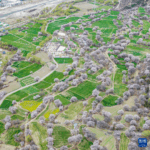
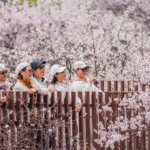


拉薩至林芝
Sie sehen gerade einen Platzhalterinhalt von YouTube. Um auf den eigentlichen Inhalt zuzugreifen, klicken Sie auf die Schaltfläche unten. Bitte beachten Sie, dass dabei Daten an Drittanbieter weitergegeben werden.
Mehr InformationenSie sehen gerade einen Platzhalterinhalt von YouTube. Um auf den eigentlichen Inhalt zuzugreifen, klicken Sie auf die Schaltfläche unten. Bitte beachten Sie, dass dabei Daten an Drittanbieter weitergegeben werden.
Mehr Informationen高原動車「綠巨人」:CR200J型復興號動車組

這款復興號動車組最高運行時速可達160公里,採用「2動8拖」的編組形式,並具備擴展至「12拖」的潛力。其最大亮點,是全球首創的「內燃+電力」雙動力牽引模式,能夠實現全程牽引順暢無需換車,真正做到了適應高原複雜環境的高效率運行。
多項關鍵技術成功填補了業界空白,標誌著中國在高原鐵路技術領域的自主創新再邁新步——這就是中國自主研發的復興號高原內電雙源動車組。
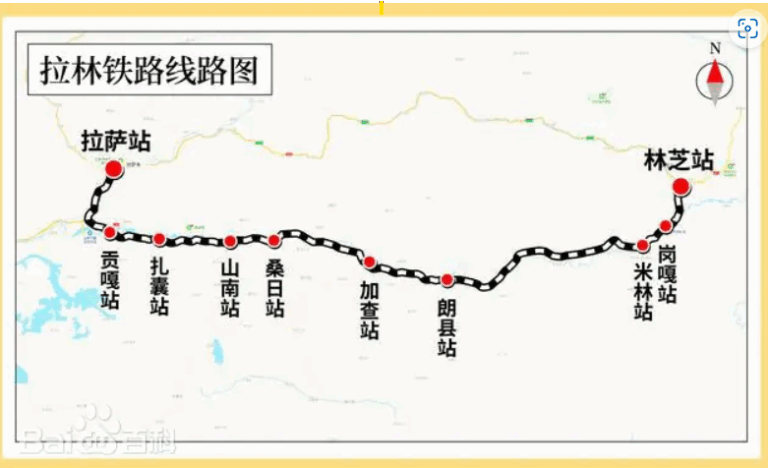
拉林鐵路是連接西藏拉薩與林芝的國鐵Ⅰ級單線電氣化鐵路,是川藏鐵路的重要組成部分。截至2022年10月,它是世界上海拔最高的電氣化鐵路,最高達到3650公尺。
鐵路起於協榮站,經由拉日鐵路接入拉薩站與拉薩南站。路線沿拉薩河行進,經貢嘎、山南、朗縣、米林,最後抵達林芝站。正線全長403.144公里,設計時速為160公里。
圖片來源:感受中国速度!踏上西藏首趟复兴号列车“绿巨人” & 拉林铁路
備註:關於「綠巨人」綽號一事,感謝中車郝曉龍先生的指點。
🤖 人工智能协作声明
本文由作者主导构思、架构与撰写,并在人工智能模型 OpenAI ChatGPT 协作下,进行语言检查、结构检测与文字润饰。所有内容均由作者独立主创完成,AI 工具仅作为语言节奏的辅助,不参与著作权主体归属。最终内容由作者人工审校并艺术化重构,承担全部创作与价值判断责任。
資料來源:
📜 本站所有原创作品均已完成区块链存证,确保原创凭证。部分重点作品另行提交国家版权登记,作为正式法律备案。原创声明与权利主张已公开。完整说明见:
👉 原创声明 & 文明节奏版权说明 | Originality & Rhythm Civilization Copyright Statement – NING HUANG
节奏文明存证记录
本篇博客文为原创作品,于博客网页首发后上传至 ArDrive 区块链分布式存储平台进行版权存证:
- 博客首发时间:请见本篇网页最上方时间标注
- 存证链接:aabaad0e-eaf8-4077-83b6-b0381c0711c1
- 存证平台:ArDrive(arweave.net)(已于 2025年7月5日 上传)
- 原创声明编号:
Rhythm_Archive_05Juli2025/Rhythm_Civilization_View_Master_Archive
© 黄甯 Ning Huang, 2025. All Rights Reserved.
本作品受版权法保护,未经作者书面许可,禁止复制、改编、转载或商用,侵权必究。
📍若未来作品用于出版、课程、NFT或国际展览等用途,本声明与区块链记录将作为原创凭证,拥有法律效力。

《节奏文明观|声音篇 —— 声音如何显形文明:世界在频率里被记住》
声音,不只是被听见,而是文明显形的方式。
从楚简的五音、乐风,到楚辞的呼唤与叩问;
从高铁美学的香气、色彩、戏曲、工艺与乐器,
到速度时代被重新激活的气息结构——
声音将这些异质的材料对齐,
让古今在同一频率上共振。
本篇追问:
一个文明,是如何通过声音保持呼吸、记忆与秩序的?
Sound is not merely heard—it is how a civilization becomes visible.
From the Five Tones and musical governance in Chu bamboo texts,
to the chants and inquiries of the Chu Ci;
from the sensory systems of High-Speed Rail Aesthetics—
aroma, color, opera, craftsmanship, instruments—
to the breath-structures reactivated in the age of speed,
sound aligns these disparate materials into a single field of resonance.
This essay asks:
How does a civilization sustain its breath, memory, and order through sound?

《节奏文明观|语法篇 ——节奏如何生成语法:意义是从停顿里长出来的》
本篇〈语法篇〉从节奏文明的视角,重新理解语法与意义的生成方式。语法并非源自规则,而是节奏在停顿中形成的秩序;意义并非来自解释,而是从停顿里生长出来。文章经由三条路径展开:感官的停顿(香气、色彩、声音、器物)、思想的停顿(楚简的断裂语法)、空间的停顿(地景与折返),呈现当停顿被排列,语法便显形;当语法被看见,文明重新获得呼吸。
This essay rethinks grammar through the lens of Rhythm Civilization. Grammar does not arise from rules but from rhythm settling into pause; meaning does not come from explanation but grows from suspension. Through sensory pauses, conceptual pauses in Chu bamboo-slip syntax, and spatial pauses in landscape, the text shows how arranged pauses generate grammar and how visible grammar allows civilization to breathe again.

《节奏文明观|系统篇 ——系统如何形成:从一条线,到一整个世界》
《系统篇》探问一个被现代世界忽略的核心:文明中的“系统”,并不是被规划、设计、建构出来的,而是从节奏中自然生长的。一条手势的线、一段呼吸的速度、一条铁轨的方向、一种工艺的重复动作,当这些节奏累积到足够密度,系统便从“线”的稳定,走向“面的对拍”,再走向“体”的自我维持。本篇解析系统如何形成三阶段的生成路径:起点是一条稳定呼吸的线;生成是线与线开始对拍、连成面;成熟是结构自我复制并成为文明的呼吸体系。系统不是框架,而是节奏的结晶;不是工程图,而是一个世界自动组织自己的方式。在这个时代,重新理解系统如何被听见、被调频、被唤醒,是人类重新学习文明的关键一步。The System Chapter explores a forgotten truth of civilization: systems are not designed—they emerge from rhythm. A single stroke of the hand, the pace of a breath, the direction of a railway line, the repetitive motion of a craft—when these rhythms accumulate with enough density, a system naturally evolves from the stability of a line, to the synchronized convergence of patterns, and finally into a self-sustaining organism. This chapter unfolds the three-phase pathway of system formation: origin as a line that breathes steadily; formation as lines begin to resonate and form a field; maturation as structure replicates itself and becomes a living rhythm of civilization. A system is not a framework but the crystallization of rhythm, not a diagram but a world that organizes itself through resonance. In an age overloaded with structures yet starved for coherence, relearning how systems are heard, aligned, and awakened becomes essential for recovering a deeper sense of civilization.
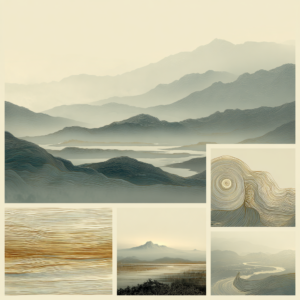
《节奏文明观|地景篇 —— 地景的学习法:用空间的节奏理解文明》
本篇探讨“地景如何成为一种学习方式”。空间具有节奏——在距离、密度与停顿中,影响我们感知记忆、行动与文明。透过阅读山河、城市与路径的节奏,我们重新理解文明如何透过身体被感受与学习。
This essay explores how landscapes become a form of learning. Space carries rhythm — in distances, densities, and pauses — shaping how we perceive memory, movement, and civilization. By listening to the tempo of mountains, cities, and pathways, we rediscover how culture is formed through the body’s response to space.
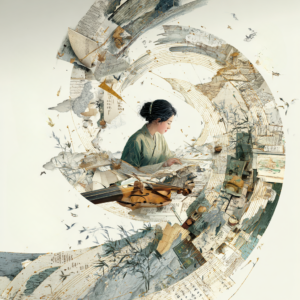
《节奏文明观|体质篇 —— 模组型体质的学习法:以节奏为师,以身体学习文明》
这篇〈模组型体质的学习法〉是我第一次认真回望,我这一生到底是怎样学习的。事实上,我的学习并不是只有直觉,也不是不用头脑,而是:身体先感到,头脑才开始理解;直觉先开门,思考随后把结构建起来。每当我进入一个陌生领域,我不是从概念开始,而是从感受与节奏开始——一旦身体抓到节奏,头脑便能迅速组织、推理、整合。无论是乐器、戏曲、香气、工艺、文学,或是楚文明的六十篇写作,我的路径始终一样:感知点亮入口,思考完成结构,文明在两者之间自动显形。我终于明白:我学习的不只是知识,而是世界如何运作。
This essay is my first honest attempt to understand how I have learned throughout my life. My learning has never been purely intuitive, nor purely intellectual. The order is simply different: the body senses first, and the mind understands afterward. Intuition opens the door; thinking builds the structure. Whenever I enter a new field, I do not begin with concepts but with sensation and rhythm—once my body catches the rhythm, my mind can quickly organize, reason, and integrate. Whether in instruments, opera, scent, craft, literature, or the sixty essays on Chu civilization, the pattern remains constant: sensation lights the entry, intellect completes the architecture, and the structure of a civilization emerges between the two. Only now do I realize that I was never learning “knowledge” alone—I was learning how the world works.

《我的人生,是一部楚居——一个非线性学习者的迁徙与文明回归》
这是一篇以《楚居》的逻辑重新阅读人生的个人叙事:七所大学、七个科系、七座城市、七种工艺、七种乐器的迁徙与学习经验。那些曾被视为“分散”的路径——学业、城市、工艺、音乐——在楚人的徙居节奏中重新排版,显现为一个非线性学习者独特的生命结构。由此展开一条“迁徙与文明回归”的路径:漂泊不再是迷失,而是一种自我命名的方式,让生命的多声部共同指向同一个根。
This essay rereads a life through the logic of Chu-Ju: seven universities, seven disciplines, seven cities, seven crafts, and seven musical instruments—each a trace of migration and learning. What once appeared as scattered paths—academia, geography, craft, and music—rearranges itself through the Chu rhythm of continual relocation, revealing the underlying structure of a nonlinear learner’s life. From this emerges a journey of migration and civilizational return: wandering becomes not a sign of being lost, but a form of self-naming, allowing the many voices of a life to point toward the same root.


